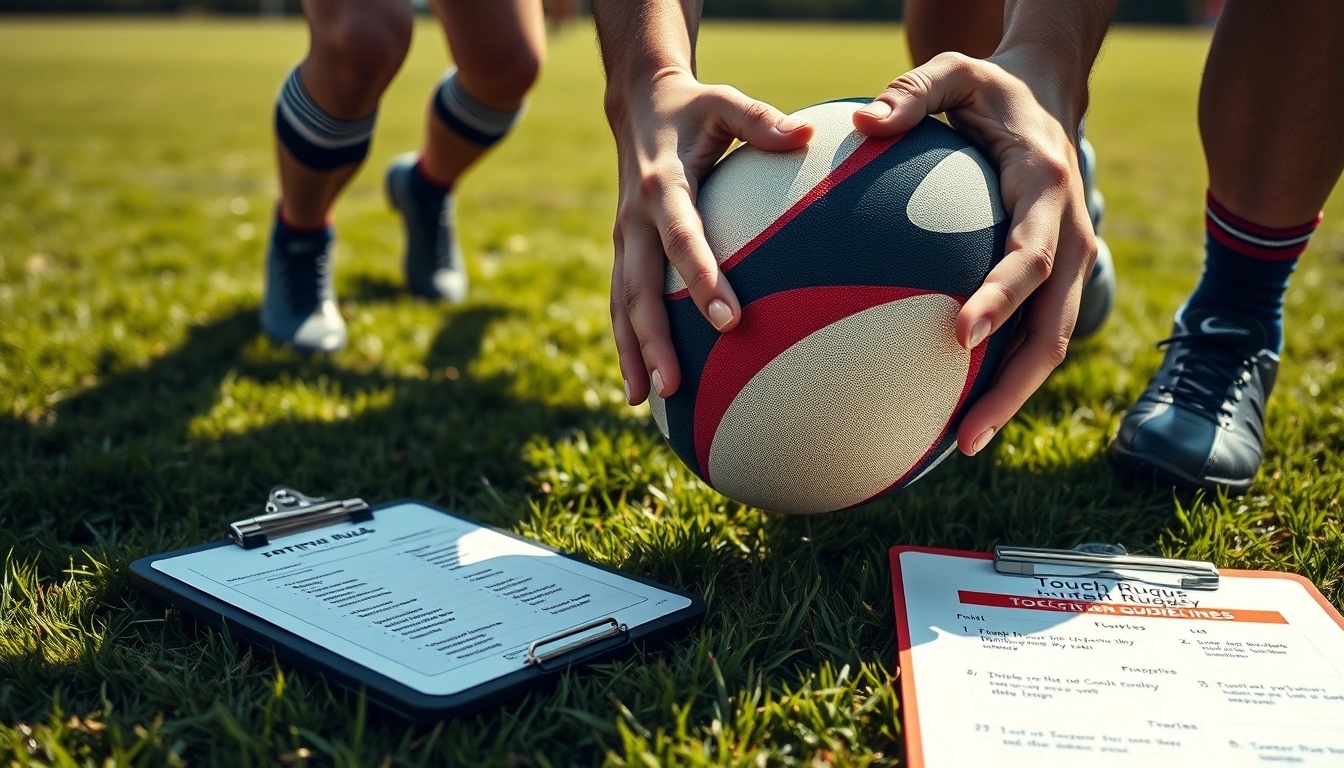Touch rugby, honestly, is like the cool, chill cousin of the rugby family. You know, the one who shows up to the party but doesn’t start any fights? For anyone who’s been eyeing rugby but got cold feet thinking about those bone-crunching tackles, touch rugby is the perfect gateway drug. It’s accessible, fun, and shockingly addictive once you get a taste. So, why exactly is it the go-to for newbies? Let’s break it down without the fluff.
First off, what is touch rugby? Well, imagine rugby but with a velvet glove instead of a steel fist. It’s a minimal-contact game where instead of tackling, you just “touch” the opponent to stop their progress. Fast-paced and energetic, it keeps the essence of rugby alive but ditches the bruises and injuries. It’s like rugby’s kinder, gentler sibling who actually wants you to stick around.
| Aspect | Touch Rugby | Traditional Rugby |
|---|---|---|
| Contact Level | Minimal (touches instead of tackles) | High (full tackles) |
| Injury Risk | Low | High |
| Equipment Needed | Minimal (just a ball) | Full protective gear |
| Suitability for Beginners | Excellent | Challenging |
One of the biggest selling points is the low injury risk. No one wants their first rugby experience to end with a trip to the ER, right? Touch rugby’s gentle approach means you can actually learn the game without fearing for your limbs. This safety net encourages rookies to dive in and make mistakes—which, let’s face it, is how you learn anything worthwhile.
Now, don’t expect to spend hours buried in rulebooks. Touch rugby comes with easy-to-grasp rules that get you playing within minutes. Forget complicated offsides or scrum debates; it’s all about quick passes, sharp moves, and teamwork. Here’s a quick rundown:
- Teams usually have 6 players on each side.
- Instead of tackles, a touch stops the player.
- The attacking team has six touches to score or lose possession.
- Simple, right? No need to be a rulebook nerd.
Fitness-wise, touch rugby is a sneaky workout. You’re sprinting, dodging, and thinking on your feet without the brutal hits that make traditional rugby a bit intimidating for newcomers. It’s a fantastic cardio workout that improves agility and endurance without the risk of getting flattened. Plus, it’s social! You’ll find yourself laughing, bonding, and maybe even making lifelong friends on the field.
| Fitness Benefits | Details |
|---|---|
| Cardiovascular Health | Continuous running and quick bursts improve heart health |
| Agility | Frequent changes in direction develop nimble feet |
| Endurance | Fast-paced game keeps stamina in check |
| Muscle Tone | Engages core, legs, and upper body without heavy strain |
If you’re worried about gear, chill out. Touch rugby requires minimal equipment — just a ball and some open space. No need to splurge on pads or helmets, which makes it super easy to start. And the best bit? Everyone’s welcome. It doesn’t matter if you’re 8 or 80, male or female, rookie or returning player. Touch rugby thrives on inclusivity, welcoming all walks of life onto the field.
So, if you’re itching to try rugby but dread the bruises, give touch rugby a go. It’s fast, fun, friendly, and frankly, a bit addictive once you get the hang of it. Who knows? It might just become your new favorite sport.
What is touch rugby?
Touch rugby is like rugby’s cheeky little cousin who shows up to the party without the bruises and the big hits. Think of it as rugby stripped down to its bare essentials — fast, fun, and fiercely competitive, but with a twist: minimal contact. Instead of bone-crunching tackles, players just touch their opponents to stop play. Sounds simple, right? Well, it is, but that simplicity is what makes it brilliant for newcomers and seasoned players alike.
Imagine a game where you can run like the wind, dodge like a magician, and pass like a pro, all without worrying about ending up flat on your back. That’s touch rugby for you. It’s a non-contact sport that keeps the heart and soul of rugby alive — the running, the strategy, the teamwork — but skips the heavy-duty collisions. This makes it a perfect stepping stone for anyone curious about rugby but hesitant about the rough stuff.
- Players and Teams: Usually, touch rugby is played with six players per side, which means there’s loads of room to move and lots of action.
- Field Size: The pitch is smaller than a full rugby field, making the game quicker and more intense.
- Gameplay: Instead of tackles, a simple touch stops the player in possession, and then the ball must be passed within a set number of touches.
Now, you might wonder, “Is it just a kiddie version of rugby?” Far from it. Touch rugby demands sharp skills — quick thinking, precise passing, and smart positioning. It’s like chess at full speed, where every touch counts. Plus, it’s a brilliant way to get fit without feeling like you’ve been through a meat grinder.
| Aspect | Touch Rugby | Traditional Rugby |
|---|---|---|
| Contact Level | Minimal (touch only) | High (tackles, scrums) |
| Number of Players | 6 per side | 15 per side |
| Field Size | Smaller | Full-sized pitch |
| Player Safety | Higher (less injury risk) | Lower (more injuries) |
| Game Pace | Fast and continuous | Variable, with stoppages |
So, if you’re itching to try rugby but dread the idea of getting flattened, touch rugby’s your best bet. It’s inclusive, easy to learn, and just downright enjoyable. Whether you’re a total newbie or a veteran looking to keep sharp without the knocks, touch rugby has got something for everyone. And hey, you might even find yourself hooked on the thrill of the chase — no bruises required.
In short: Touch rugby is the perfect blend of speed, skill, and safety, making it an ideal gateway into the world of rugby. Give it a go, and you’ll quickly see why it’s gaining popularity across schools, clubs, and communities worldwide.
Low injury risk makes it beginner-friendly
Let’s be honest, one of the biggest hurdles for anyone thinking about trying rugby is the fear of getting absolutely smashed on the pitch. Those bone-crunching tackles, flying elbows, and accidental faceplants? Yeah, they’re enough to scare off even the most enthusiastic newbie. But here’s where touch rugby swoops in like a superhero wearing a soft jersey. Because, unlike its full-contact cousin, touch rugby is all about the fun and speed without the nasty bruises. It’s a game that lets beginners dip their toes in the rugby pool without the risk of walking away looking like they’ve been through a blender.
You see, the essence of touch rugby is minimal contact. Instead of tackling, players simply touch their opponents to stop play. That small tweak changes everything. No more bone-jarring collisions or worrying about a rogue tackle that leaves you flat on the ground. It’s like rugby’s gentler sibling, who’s happy to play but won’t throw you into the wall. This means fewer injuries, less downtime, and a whole lot more smiles on the field. For beginners still figuring out the game’s flow, that safety net is a massive confidence booster.
| Type of Injury | Touch Rugby | Full Contact Rugby |
|---|---|---|
| Sprains & Strains | Low | High |
| Bruises & Contusions | Minimal | Frequent |
| Concussions | Rare | Common |
| Fractures | Very Rare | Occasional |
Now, don’t get me wrong — “minimal contact” doesn’t mean there’s zero risk. You might still trip over your own feet or bump into a mate when you’re all hyped up running around like a headless chicken. But compared to the full-contact version, the chance of a serious injury is way, way lower. This is a game where you can learn the ropes, practice your passing, and get a feel for the pace without constantly looking over your shoulder for a flying tackle. It’s almost like rugby’s training wheels.
- Beginners can focus on skill-building: Without the looming threat of injury, newbies can actually concentrate on learning how to pass, catch, and position themselves.
- Parents and coaches love it: Because it’s safer, it’s a popular choice for kids and youth programs, giving parents peace of mind.
- Less downtime: Injuries can bench players for weeks, but touch rugby keeps you on your feet and in the game.
Here’s a practical insight for anyone thinking about jumping in: if you’re the cautious type, or maybe someone who’s been out of sports for a while, touch rugby is a golden ticket. It’s like dipping your toes in the water before diving headfirst. And trust me, once you get a taste of the fast-paced runs and quick passes, you’ll be hooked — minus the fear of getting flattened like a pancake.
So, if the idea of rugby excites you but the thought of bruises and broken bones doesn’t, touch rugby might just be your perfect match. It’s the safe, fun, and social way to get started — no helmets, no pads, just pure, unfiltered rugby joy. And who knows? Maybe one day you’ll graduate to full-contact, but for now, enjoy the ride without the ouch.

Easy rules that anyone can grasp
Alright, let’s be honest here—when you first hear about rugby, your brain might start doing somersaults trying to decode all those complicated rules and referee signals. But here’s the good news: touch rugby tosses all that confusion out the window. It’s like rugby’s chill little cousin who just wants everyone to have fun without sweating over rulebooks thicker than a novel.
First off, the game is minimal contact. No bone-crunching tackles or wrestling on the grass. Instead, a “touch” replaces a tackle—just a simple tap with the hand on your opponent. Simple, right? This means the game flows faster, and newbies can focus on running, passing, and dodging without worrying about getting flattened.
- Six touches and turnover: Each team gets six chances (or touches) to move the ball downfield. After the sixth touch, if you haven’t scored, the ball goes to the other team. Keeps the game moving and the pressure on.
- No kicking allowed: Yep, leave those fancy kicks for full-contact rugby. Touch rugby keeps it all about running and passing.
- Offside rules are relaxed: Unlike traditional rugby where offside can be a headache, touch rugby’s offside line is straightforward—players must retreat 5 meters after a touch, keeping things fair but not hair-pulling.
- Quick restarts: After a touch, the game restarts immediately with a roll ball (think of it as a quick tap and roll). No time wasted standing around.
| Rule | Explanation | Why it’s beginner-friendly |
|---|---|---|
| Touch instead of tackle | Tagging the opponent with a hand replaces tackling | Less physical risk, easier to learn |
| Six touches per possession | Teams have six touches to score before turnover | Keeps gameplay brisk and simple |
| No kicking | Kicking the ball is not allowed | Focuses on running and passing skills |
| 5-meter retreat | Defensive players retreat 5 meters after a touch | Easy to grasp positioning rule |
Honestly, the beauty of touch rugby is that you can explain the entire game in just a few minutes, and then boom—you’re off running around, laughing, and sometimes tripping over your own feet (been there, done that). No need to memorize fifty different penalties or referee hand signals. The simplicity means it’s perfect for people who want to jump straight into the action without feeling like they’re back in school trying to cram for a test.
Plus, because it’s so straightforward, it’s a great equalizer. Kids, adults, seasoned athletes, or complete newbies can all hit the field and enjoy the game together. No one’s left scratching their heads wondering if they’re following the rules correctly. Everyone just plays.
So, if you’ve been scared off by the idea of rugby’s complexity or worried about getting roughed up, touch rugby’s easy-to-understand rules will make you think, “Hey, I can totally do this.” It’s all about fun, fitness, and friendly competition without the headache.
Quick tips for beginners to get the hang of the rules:
- Focus on passing quickly—it keeps the defense guessing.
- Remember, one hand touch counts; no wrestling allowed.
- Keep track of the touches—after six, hand over the ball.
- Stay behind the 5-meter line when defending.
In the end, touch rugby’s uncomplicated rules are the secret sauce that makes it accessible, fast-paced, and downright enjoyable for everyone who wants to give rugby a go without the fuss. So, grab a ball, find a patch of grass, and get ready to dive into one of the friendliest sports around!
Fitness benefits without the strain
Touch rugby is like that sneaky fitness friend who shows up unannounced but leaves you feeling great—no bone-crunching tackles, no bruises, just pure cardio fun. Seriously, if you’re the type who’s always wanted to get into rugby but the thought of getting flattened by a 250-pound prop scares the life outta you, touch rugby is your golden ticket. It delivers a solid cardiovascular workout that pushes your heart rate up, boosts endurance, and sharpens agility without the physical punishment. Sounds like a dream, right?
Now, let’s not kid ourselves—this isn’t some lazy stroll in the park. Touch rugby moves fast, demands quick thinking, and keeps you darting around the pitch like a caffeinated squirrel. The constant bursts of speed and direction changes work wonders for your aerobic and anaerobic systems. You’re basically doing interval training disguised as a game, which means calorie burn and stamina improvements are just part of the package.
- Endurance: The continuous movement keeps your lungs and heart pumping, building stamina over time.
- Agility: Dodging opponents and making sharp turns enhances coordination and reflexes.
- Speed: Sprinting short distances repeatedly helps increase your overall pace.
And here’s the kicker: no heavy tackles means your joints and muscles get a break from the usual rugby battering. That’s why it’s a favorite for beginners, older players, or anyone nursing a dodgy knee but still craving some competitive action.
| Aspect | Touch Rugby | Full-Contact Rugby |
|---|---|---|
| Cardio Intensity | High (steady running, quick bursts) | High (running plus heavy physical exertion) |
| Injury Risk | Low (minimal contact) | High (tackles, scrums, collisions) |
| Muscle Strain | Moderate (focus on speed, agility) | High (strength, impact) |
But don’t get it twisted—just because it’s “touch” doesn’t mean it’s a walkover. You’ll still be sweating buckets, catching your breath, and wondering if you’ve got the lungs of a marathon runner or the stamina of a couch potato. Plus, the social vibe keeps you coming back. When you’re running drills, passing the ball, and laughing off those near-misses, the workout sneaks up on you.
Here’s a quick tip for all the newbies: focus on your footwork and positioning. The game rewards nimbleness and smart play over brute force. So, lace up those trainers, grab a ball, and get ready to work your heart out without the fear of getting flattened like a pancake.
Key Takeaways:- Touch rugby cardio + agility + fun, minus the bruises.- Great for all fitness levels, especially beginners.- Keeps joints safe while boosting overall endurance.- Social, fast-paced, and surprisingly challenging.
In short, if you want to get fit without the fear of faceplants or crushed ribs, touch rugby is a fantastic option. It’s like rugby’s kinder, gentler cousin who still knows how to throw a good party on the pitch. Give it a whirl—you might just find yourself hooked.
Social aspect: Making friends on the field
Touch rugby isn’t just about chasing a ball around a field; it’s a vibrant social scene where friendships sprout faster than you can say “try!” For beginners, this is a game-changer. Imagine stepping onto the field for the first time, nerves jangling, and instead of feeling like the odd one out, you’re greeted with smiles, high-fives, and a chorus of “Welcome to the team!” It’s like walking into a party where everyone’s there to have a blast—and you’re instantly part of it.
The beauty lies in the shared experience. Beginners bond over the inevitable fumbles, missed passes, and those hilarious moments when someone trips over their own feet. Laughter becomes the glue that holds the team together, breaking down barriers quicker than any icebreaker game at a corporate retreat. And honestly, where else can you find a bunch of strangers turning into mates simply by chasing a ball and tagging each other?
- Teamwork builds trust: As you coordinate plays and cover for each other, trust naturally forms. It’s not just about winning; it’s about knowing your teammate’s got your back.
- Inclusive vibe: Touch rugby welcomes all shapes, sizes, and skill levels. No egos, just encouragement. Beginners feel comfortable asking questions and learning without judgment.
- Post-game socials: The fun doesn’t stop when the whistle blows. Many clubs host casual meet-ups, BBQs, or drinks, making it easy to deepen friendships off the field.
| Social Benefit | What It Means for Beginners |
|---|---|
| Sense of Belonging | Feeling accepted and valued in a new community |
| Communication Skills | Learning to express ideas and listen effectively during play |
| Confidence Boost | Gaining self-assurance through positive team interactions |
But hey, it’s not always sunshine and rainbows. Sometimes, newbies might feel overwhelmed by the fast pace or worry about keeping up. That’s where the social aspect really shines—it’s a support network. Veteran players often step in with tips, encouragement, or just a friendly pat on the back. This camaraderie eases the pressure and turns “I hope I don’t mess up” into “Let’s have some fun!”
Plus, touch rugby’s social nature means you’re not just making friends for the season. Many lifelong friendships have kicked off on these fields. You’ll find yourself texting teammates about weekend plans, sharing memes, or even organizing group workouts. It’s a community that extends beyond the game, proving that sport can be a powerful connector.
So, if you’re a beginner wondering whether you’ll fit in, remember this: touch rugby is less about perfection and more about participation, laughter, and connection. It’s a place where you can be yourself, make mistakes, and still be cheered on. The friendships you forge here? They’re the kind that stick—because they’re built on shared sweat, smiles, and a whole lot of fun.
In short: Touch rugby is not just a sport. It’s a social playground where beginners find more than just a game—they find a community.

Skill development for future rugby stars
Touch rugby isn’t just a casual kickabout with a ball; it’s a sneaky little powerhouse for sharpening the core skills every rugby hopeful needs. You see, before you’re smashing through tackles or sprinting down the pitch in full contact glory, you gotta nail the basics—passing, catching, and spatial awareness. And guess what? Touch rugby hones these like a pro coach with a whistle and a clipboard.
First off, passing. It’s the bread and butter of rugby, and touch rugby forces you to get it right. No wild throws or hoping for the best here—precision and timing are everything. Since the game’s fast-paced and there’s no tackling to slow you down, you gotta be sharp, quick, and accurate with your passes. It’s like a crash course in ball handling that’ll save your skin when things get rough in full-contact matches.
| Skill | How Touch Rugby Helps | Why It Matters |
|---|---|---|
| Passing | Encourages quick, accurate ball distribution under pressure | Sets up attacking plays and keeps the team moving fluidly |
| Catching | Improves hand-eye coordination and reaction times | Ensures possession is maintained, even in tight situations |
| Spatial Awareness | Develops understanding of positioning and player movement | Helps anticipate opponents’ actions and exploit gaps |
Now, onto catching. Sounds simple, right? But when you’re darting around, dodging opponents, and the ball’s coming at you like a rocket, catching cleanly is a skill that separates the stars from the benchwarmers. Touch rugby drills this relentlessly because every touch counts and dropping the ball can cost your team dearly. This constant practice sharpens your reflexes and boosts confidence, so when the big leagues call, you’re not fumbling under pressure.
And then there’s the often overlooked but absolutely critical spatial awareness. In touch rugby, your ability to read the field, anticipate where teammates and opponents will be, and find open spaces is put to the test every single play. It’s like a chess match on grass, where your brain’s gotta be as quick as your feet. This skill is pure gold for anyone dreaming of full-contact rugby because knowing where to be and when can make or break a game.
- Quick decision-making: Touch rugby’s pace forces players to think fast, making split-second choices that build game intelligence.
- Team communication: With no heavy tackles, players rely more on verbal cues and signals, strengthening on-field communication.
- Agility and footwork: Dodging touches sharpens your ability to change direction swiftly—crucial for evading tackles later on.
So, if you’re eyeing a future in rugby, don’t scoff at touch rugby as just a “soft” version. It’s a secret training ground packed with opportunities to polish fundamental skills without the bruises and scrapes. Plus, it’s heaps of fun and, let’s be honest, a lot less scary for beginners. Think of it as the warm-up act before the main event.
In short, touch rugby builds confidence, hones essential skills, and prepares you mentally and physically for the rougher stuff. It’s where rugby stars of tomorrow cut their teeth, learning the craft in a friendly, supportive environment. So, lace up, grab a ball, and get ready to sharpen those passing, catching, and spatial skills—you’ll thank yourself when you’re out there smashing it in the full-contact arena.
Inclusivity: All ages and genders welcome
If there’s one thing that truly sets touch rugby apart from a lot of other sports, it’s how welcoming and inclusive it is. Seriously, this game throws open its doors to just about anyone willing to give it a go — no matter your age, gender, or experience level. It’s like the cool kid in school who never turns anyone away from the lunch table. And honestly, that’s a breath of fresh air in a world where sports can sometimes feel like exclusive clubs with secret handshakes.
Why does touch rugby manage to be so inclusive? Well, for starters, the minimal contact nature means it’s not intimidating for people who might shy away from full-contact rugby. You don’t have to worry about getting body-slammed or bruised up. Instead, it’s all about quick reflexes, teamwork, and a bit of strategy — stuff that anyone can pick up. Plus, because it’s less about brute strength and more about skill and agility, it naturally levels the playing field between men, women, kids, and older players alike.
| Age Group | Why Touch Rugby Works | Typical Benefits |
|---|---|---|
| Kids (6-12 years) | Safe, fun introduction to team sports | Coordination, social skills, basic fitness |
| Teens (13-19 years) | Builds confidence and competitive spirit | Endurance, teamwork, agility |
| Adults (20-50 years) | Low injury risk keeps it accessible | Fitness, stress relief, social networking |
| Seniors (50+ years) | Gentle on joints, promotes active lifestyle | Mobility, balance, community engagement |
And it’s not just about age — gender inclusivity is baked right into the game’s ethos. Mixed-gender teams are the norm, not the exception. This means women and men get to play side-by-side, which is pretty awesome when you think about how many sports still struggle with gender segregation or unequal opportunities. It’s a great way to smash stereotypes and show that athleticism and fun aren’t limited by gender lines.
- Mixed teams encourage mutual respect and understanding.
- Everyone learns from different playing styles.
- Creates a supportive environment that values effort over ego.
Now, don’t get me wrong — touch rugby isn’t perfect. Sometimes newbies might feel a bit out of place if they’re the only person from their demographic on the team. But generally, the community vibe is so strong that people quickly feel like they belong. Coaches and clubs often emphasize creating a safe, judgment-free zone where everyone’s welcome to mess up, laugh, and try again.
So, if you’ve been sitting on the sidelines thinking, “Nah, rugby’s not for me,” maybe give touch rugby a shot. It’s like the sport’s way of saying, “Hey, come one, come all!” Whether you’re a sprightly 8-year-old or a spry 70-year-old, whether you identify as male, female, non-binary, or just “someone who loves a good game,” touch rugby’s got a spot for you. And honestly? That’s pretty darn cool.
Quick Tips for Finding Inclusive Touch Rugby Groups:
- Look for community centers or local sports clubs advertising mixed-age and mixed-gender leagues.
- Check social media groups dedicated to touch rugby — they often highlight beginner-friendly sessions.
- Don’t hesitate to ask about the club’s inclusivity policies or if they welcome complete newbies.
In the end, inclusivity isn’t just a buzzword for touch rugby — it’s part of what makes the game so darn enjoyable. So grab a ball, round up some mates (or strangers!), and jump into a sport that’s as open-minded as it is fast-paced. You might just find your new favorite pastime.
Minimal equipment, maximum fun
Look, if you’re thinking about diving into touch rugby but your wallet’s already waving a white flag, breathe easy. This sport is a rare gem where you don’t need to blow a fortune on fancy gear or those intimidating pads that make you look like a walking tank. Seriously, all you really need is a ball and a decent patch of open space. That’s it. No, really. No expensive boots, no helmets, no shoulder guards. Just pure, unadulterated fun.
Why is this such a big deal? Well, for starters, it lowers the bar for entry. Imagine trying to pick up a sport where you’re expected to shell out hundreds of dollars before you even kick the ball. That’s a buzzkill. Touch rugby, on the other hand, is like the cool kid who invites everyone to the party—no cover charge, no dress code. You can literally grab a ball from your local park, find a few mates, and start playing. It’s that simple.
- The Ball: A standard touch rugby ball is pretty affordable and widely available. But hey, if you’re desperate, any rugby-style ball will do. Even a slightly deflated one adds to the charm.
- Open Space: A park, a beach, a school field, or even a backyard—space is all you need. Touch rugby thrives on open areas where players can sprint, dodge, and strategize.
| Equipment | Necessity | Cost |
|---|---|---|
| Touch Rugby Ball | Essential | Low (~$20-$30) |
| Sports Shoes | Recommended | Varies |
| Protective Gear | Not Needed | None |
| Open Field | Essential | Free |
Now, don’t get me wrong, some folks might argue that having the right shoes or a jersey adds to the experience—and sure, it does—but these are luxuries, not necessities. The beauty of touch rugby is its accessibility. You can be rocking up in your everyday trainers, or even barefoot if you’re feeling adventurous (though, maybe not the smartest choice if the field’s a bit dodgy).
And here’s a little secret: the minimal equipment means you’re less likely to get bogged down by the “stuff” and more focused on the actual game. No fumbling with straps, no worrying about gear malfunctioning mid-play. It’s just you, the ball, and the thrill of the chase. Plus, the simplicity encourages more spontaneous games—those impromptu matches that pop up in parks or on weekends with friends. It’s the kind of sport that fits into your life rather than demanding you reshape your schedule around it.
So, if you’re the type who’s always hesitated to try rugby because of the gear hassle or the fear of looking like a newbie with all the wrong equipment, touch rugby is your golden ticket. Minimal fuss, minimal cost, and maximum fun. What’s not to love?
Quick Tips to Get Started with Minimal Gear:
- Scout out local parks or school fields—most have enough space for a casual game.
- Borrow or buy a basic rugby ball; it’s an investment that lasts.
- Gather a group of friends or join a beginner-friendly local touch rugby meetup.
- Wear comfortable clothes and shoes—you’ll be moving a lot!
- Don’t sweat the small stuff; focus on the fun and learning.
In the end, touch rugby strips the sport down to its essentials—teamwork, speed, and a whole lot of laughs—without drowning you in equipment or expenses. So grab a ball, find some open space, and get ready to have a blast. Who knew minimal gear could lead to maximum fun?

How to find local touch rugby clubs
Alright, so you’ve decided to give touch rugby a whirl—smart move! But now comes the tricky part: finding a local club where you won’t feel like a total newbie lost at sea. Don’t sweat it; diving into a new sport can be intimidating, but with a few handy tips, you’ll be running those quick passes in no time. Here’s the lowdown on tracking down nearby touch rugby clubs or social leagues that welcome beginners with open arms.
- Start with online searches: Yep, the internet is your best friend here. Try typing in “touch rugby clubs near me” or “beginner touch rugby leagues” along with your city or town name. You’ll often find club websites, Facebook pages, or Meetup groups where people post about upcoming games and socials.
- Check community centers and sports halls: Local gyms, community centers, or even school sports facilities sometimes host touch rugby sessions or have bulletin boards with flyers. Swing by and ask around—sometimes the best info comes from chatting with the folks who run these places.
- Social media groups: Facebook groups, Instagram pages, or even Reddit communities dedicated to rugby or local sports can be goldmines. People often post beginner-friendly events or casual games where you can just show up and join.
Now, a little nugget of wisdom: don’t be shy about reaching out. Most clubs love new players, especially beginners. Drop them a message, ask questions, and mention you’re new to the game. You’ll find that most teams are pretty chill and eager to help you settle in.
| Method | Pros | Cons |
|---|---|---|
| Online Search | Quick, lots of info, easy to compare options | Can be overwhelming, some clubs may have outdated info |
| Community Centers | Personal interaction, local tips, direct access to flyers | Limited hours, might require visiting in person |
| Social Media Groups | Real-time updates, community vibe, easy to ask questions | Info overload, sometimes cliques form, hard to gauge club culture |
One thing to keep in mind: many touch rugby clubs run “social leagues” or “beginner nights” specifically designed to make rookies feel comfortable. These are casual, low-pressure games where the emphasis is on fun and learning, not winning at all costs. If you stumble upon a club that only seems to focus on competitive leagues, keep looking — you want a place where you can laugh at your own fumbles without judgment.
Here’s a quick checklist to make your search easier:
- Look for clubs advertising beginner-friendly sessions
- Ask if they provide coaching or mentoring for newbies
- Check if the club has mixed-age or mixed-gender teams (touch rugby loves inclusivity!)
- Confirm practice times fit your schedule—nothing worse than missing out because of a clash
- Find out about any fees or equipment needed (spoiler: usually minimal)
Finally, remember that joining a club is as much about the social vibe as the sport. If the group feels welcoming and you enjoy their energy, you’ve hit the jackpot. Don’t be afraid to try a few clubs before settling down. After all, touch rugby is all about having a blast, meeting new mates, and maybe scoring a cheeky try or two. So lace up those trainers and get out there—you’ll be surprised how quickly you go from “fish out of water” to “part of the pod.”
Happy hunting and happy playing!
Common beginner mistakes and how to avoid them
Alright, so you’ve decided to give touch rugby a whirl—smart move! But before you step onto the pitch and start dreaming of glory, let’s talk about some classic newbie blunders that could have you tripping over your own feet (literally) or worse, becoming the team’s comic relief. No shame in messing up, but a little heads-up can save you from those “oh no” moments.
- Thinking it’s just like regular rugby: Nope, touch rugby is a whole different beast. The lack of heavy tackles means you gotta rely more on speed, agility, and quick thinking. Beginners often try to muscle through like in contact rugby and end up out of breath or offside. Remember, it’s about finesse, not force.
- Ignoring the basics of positioning: Standing around like a lost tourist is a rookie move. Touch rugby demands constant movement and awareness. If you’re not where you should be, you’re basically gifting the ball to the other team. Keep your eyes peeled and always be ready to sprint or pass.
- Overcomplicating the passing game: Trying fancy flicks or behind-the-back passes might look cool on YouTube, but in reality, they often end in disaster. Stick to simple, crisp passes to keep the flow going and avoid turnovers.
| Mistake | Why it Happens | How to Avoid |
|---|---|---|
| Being Static on Field | Uncertainty about where to go or what to do | Keep moving, communicate with teammates, watch the ball |
| Overthinking Passes | Trying to show off or nervousness | Practice straightforward passes, focus on timing |
| Not Understanding Touch Rules | Confusing contact rugby rules with touch rugby | Study the rulebook, ask questions, watch games |
Now, let’s get real for a sec—everyone’s gonna mess up at first. If you’re not tripping over your own feet or accidentally tagging the wrong player, you’re probably not trying hard enough. But here’s a nugget of wisdom: embrace those mistakes. They’re your best teachers. Just don’t get stuck in the same rut.
- Practical tip #1: Practice your footwork off the field. Touch rugby is fast. If your feet aren’t quick and light, you’ll be chasing shadows.
- Practical tip #2: Communicate like a pro. Call out passes, alert teammates about defenders, and don’t be shy to ask for help. Silence on the pitch is a recipe for chaos.
- Practical tip #3: Watch and learn. Spend some time watching experienced players or matches online. You’ll pick up positioning, timing, and the subtle tricks that don’t make it into the rulebook.
Remember:- Touch minimal contact, so no need to prepare for bone-crunching tackles.- Speed and agility beat brute strength here.- Keep your head in the game, but don’t be afraid to laugh at your slip-ups.
In the end, touch rugby is about having fun while learning a sport that’s as friendly as it is fast. So don’t sweat the small stuff—just get out there, make some mistakes, and enjoy the ride. You’ll be surprised how quickly those rookie errors turn into smooth moves.
Game on!
Touch rugby’s role in schools and community programs
Touch rugby has been quietly but steadily making waves in schools and community centers across the country. It’s like the underdog sport that suddenly everyone wants a piece of—and for good reason. Unlike traditional rugby, which can seem intimidating with its full-contact tackles and complex rules, touch rugby offers a way to get everyone involved without the fear of bruises and broken bones. This makes it a perfect fit for kids and adults alike who want to stay active and have fun without the hardcore physicality. Schools especially love it because it promotes fitness and teamwork while keeping things lighthearted and inclusive.
Now, you might wonder, why is touch rugby becoming such a staple in community programs? Well, it’s simple: it’s accessible. No need for expensive gear or a giant field—just a ball, some cones, and a few enthusiastic players. Plus, the rules are straightforward enough that even the most sports-clueless can jump right in. This has proven to be a game-changer for schools aiming to engage students who might otherwise shy away from traditional sports. It’s a sport that welcomes all skill levels, ages, and genders, making it a fantastic tool for fostering social connections and breaking down barriers.
| Benefit | Description |
|---|---|
| Improved Fitness | Boosts cardiovascular health, agility, and overall endurance without the injury risk of full-contact rugby. |
| Teamwork & Communication | Encourages players to strategize and cooperate, building essential social skills. |
| Inclusivity | Welcomes participants regardless of age, gender, or athletic ability. |
| Low Equipment Costs | Minimal gear needed, making it budget-friendly for schools and community centers. |
And let’s be honest, the social aspect is huge here. Kids and adults alike get to bond over shared goals, laughs, and the occasional “Oops, that was my bad!” moment. It’s not just exercise—it’s a community builder. Coaches and program leaders often report that touch rugby helps shy or less athletic kids come out of their shells. The game’s fast pace keeps everyone on their toes, and because it’s less about brute strength, it levels the playing field so that everyone can shine.
- For kids: It’s a fantastic way to develop coordination, spatial awareness, and basic rugby skills without the pressure of full contact.
- For adults: It’s a fun, social way to stay fit, meet new people, and relive some of that youthful competitive spirit.
- For schools: It’s an affordable, inclusive physical activity that ticks all the boxes for PE programs.
Despite all the positives, some skeptics still question if touch rugby can hold up against more traditional sports in terms of popularity and engagement. But honestly, the numbers don’t lie. Participation rates in touch rugby programs have been climbing steadily, and with good reason. It’s just plain fun. Plus, it’s a great stepping stone for those who might want to try full-contact rugby later on but aren’t quite ready to dive in headfirst.
Practical tips for schools and centers starting touch rugby programs:- Start with simple drills focusing on passing and catching.- Emphasize teamwork over competition in the early stages.- Keep sessions short and engaging to hold attention.- Encourage mixed-gender teams to boost inclusivity.- Use local touch rugby clubs as resources for coaching and equipment.
In short, touch rugby is proving itself as a powerhouse for promoting health, camaraderie, and inclusivity in schools and community programs. It’s got that rare combo of being easy to pick up, safe to play, and ridiculously fun. So, if your local school or community center hasn’t jumped on the touch rugby bandwagon yet, maybe it’s time they did. After all, who wouldn’t want to be part of a sport that’s all about fitness, friendship, and a good dash of cheeky competition?

Why touch rugby could be your new favorite sport
Alright, so you’ve heard of rugby, right? The big hits, the mud, the bruises, the relentless scrums… but what if I told you there’s a version of rugby that’s more about speed, smarts, and just plain fun, without the risk of ending up in a cast? Enter touch rugby — the game that’s sneaking its way into hearts and parks worldwide, and honestly, it might just be the sport you didn’t know you needed.
First off, touch rugby is fast. Like, blink and you’ll miss it fast. The pace keeps your heart pumping, your legs moving, and your brain working overtime. It’s not just a run-around; it’s a tactical dance where passing and positioning can make or break your game. Forget waiting around for a break in play — here, the action is nonstop.
- Minimal contact: No bone-crunching tackles, just quick touches to stop the ball carrier.
- Inclusive: Everyone’s welcome — age, gender, skill level, you name it.
- Simple rules: No need to memorize a novel; most players get the gist in minutes.
So why does this matter? Well, if you’re new to rugby or just someone who’s been scared off by the full-contact version, touch rugby is a gentle introduction. It’s like dipping your toes in the water instead of cannonballing into the deep end. Plus, the lower injury risk means you won’t have to explain that black eye at work or school.
| Benefit | Why it Rocks |
|---|---|
| Fitness boost | Cardio, agility, and endurance without the joint-jarring tackles. |
| Social vibes | Instant community — teammates become friends, and laughs are guaranteed. |
| Skill building | Improves passing, catching, spatial awareness — all essentials if you want to go full-contact later. |
| Minimal gear | Just a ball and some open space. No expensive kit needed. |
But don’t think it’s all sunshine and rainbows. Touch rugby can be surprisingly challenging. Timing your passes, reading the defense, and staying sharp under pressure is no joke. You’ll fumble, you’ll trip, and yes, you might get a little winded — but that’s part of the charm.
Here’s a quick pro tip list for newbies:
- Keep your passes crisp and quick — hesitation kills momentum.
- Stay on your toes; the game shifts in a heartbeat.
- Don’t be shy — communication is key. Shout, signal, make noise!
- Watch others and learn — every player has a trick up their sleeve.
At the end of the day, touch rugby is more than just a sport — it’s a community builder, a fitness hack, and a whole lot of fun rolled into one. Whether you’re looking to make new friends, get fit without the “ouch,” or just try something different, this game has a way of pulling you in and refusing to let go.
So, ready to give it a shot? Grab a mate, find a local club, and dive into the fast, friendly world of touch rugby. Who knows? It might just steal your heart — and keep you coming back for more.
Frequently Asked Questions (The title must be written in English.)
- What exactly is touch rugby?
Touch rugby is a fun, fast-paced version of rugby that focuses on minimal contact. Instead of tackling, players “touch” their opponents to stop play, making it a safer and more approachable game, especially for beginners.
- Is touch rugby suitable for people of all ages and fitness levels?
Absolutely! One of the best things about touch rugby is its inclusivity. Whether you’re a kid, a teen, or an adult, and no matter your fitness level, touch rugby welcomes everyone to join in the fun without feeling left out or overwhelmed.
- Do I need special equipment to play touch rugby?
Not really. Unlike full-contact rugby, touch rugby requires minimal gear. All you need is a rugby ball and some open space. This makes it easy to start playing without breaking the bank on expensive equipment.
- How risky is touch rugby in terms of injuries?
Touch rugby is much safer than traditional rugby because it eliminates heavy tackles. The risk of injury is significantly lower, which makes it perfect for beginners who want to enjoy the sport without the fear of getting hurt.
- Where can I find local touch rugby clubs or teams?
Finding a local club is easier than you think! Check community centers, sports clubs, or online platforms dedicated to rugby. Many areas have social leagues designed specifically for beginners, so you’ll never feel out of place.
- What skills can I develop by playing touch rugby?
Touch rugby is excellent for honing key rugby skills like passing, catching, and spatial awareness. These foundational skills are crucial if you ever decide to transition to full-contact rugby or just want to improve your overall game.
- Are the rules complicated for someone new to rugby?
Not at all! Touch rugby’s rules are straightforward and easy to pick up. This simplicity allows beginners to jump right into the game without spending hours memorizing complex regulations.
- How does touch rugby help with fitness?
Playing touch rugby gives you a fantastic cardio workout that boosts endurance and agility. Since it avoids heavy contact, you get all the fitness benefits without the physical strain that often scares newcomers away.
- Can touch rugby help me make new friends?
Definitely! Touch rugby is as much about socializing as it is about sport. It creates a friendly environment where you can meet people, share laughs, and build lasting bonds on and off the field.
- Why is touch rugby becoming popular in schools and communities?
Schools and community programs love touch rugby because it promotes teamwork, fitness, and inclusivity. It’s a fun way to get people active and engaged without the intimidation factor of full-contact sports.












